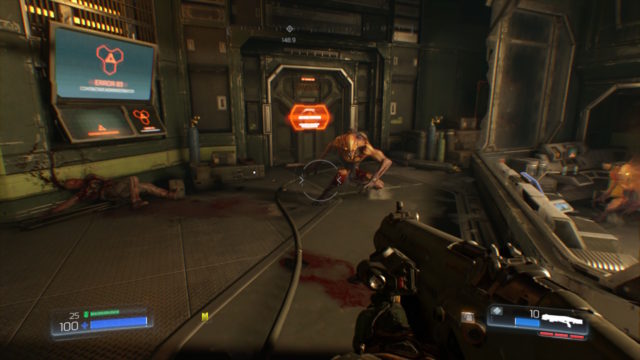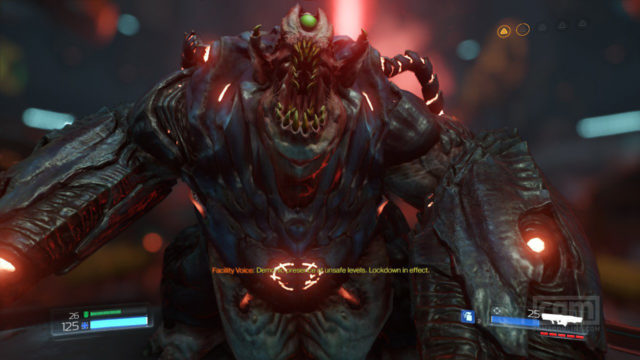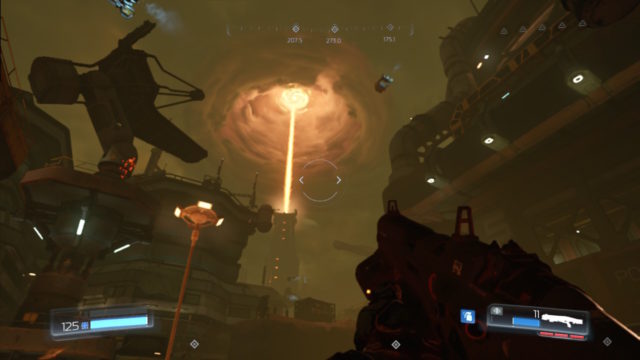Great campaign with meaningful exploration and intense combat; Arcade mode is perfect for quick sessions; fun online multiplayer with compelling progression; brutal yet gorgeous visuals; perfect music for the tone and style.
Some might be turned off by aggressive tone and gore; occasional visual hiccups during the most intense action; first person platforming is a little loose; some optional objectives distract from the game's flow.
Doom premiered last year on PC and current generation consoles to significant commercial and critical success. The general consensus was that it managed to pay homage to the highly influential original while simultaneously updating its core principles and pushing the FPS genre in a different direction. For those who have played Doom or read up on it, the question of whether or not it is a good game has already been answered — it’s fantastic. But now, it’s on Switch, a console designed around the principle of flexible portability instead of raw processing power. This means we now have to ask how well Doom has transitioned to its new home.
For the uninitiated, Doom is an FPS that’s unapologetic in its focus on fast, brutal fun. The single player campaign is the centerpiece of the package, and while it does offer an interesting story for those willing to pay attention to the world and read the large amounts of flavor text, the core premise is simple: researchers working for a greedy corporation on Mars opened a gateway to hell and it’s your job as the Doom Guy to fix this mess while reducing every demon in your way to a pile of gore. What’s great is how well this straightforward idea is communicated through the silent protagonist. Like many games, there are talking heads telling you what to do and how to do it, but Doom Guy always chooses to execute his objectives with extreme prejudice, ignoring pleas to help preserve research and infrastructure. He’s not there to save the facility or its technological breakthroughs, he just wants to erase any and every mark Hell has left upon the planet.
While the campaign progresses through a linear set of levels, each stage is actually fairly open. You always are given several objectives to complete and frequently have a certain amount of freedom in what order you choose to tackle them. Just like in the original, most stages feature a set of colored keys and corresponding doors they open, so this does give the game more order and structure than a true sandbox title, but it never devolves into feeling like just another corridor shooter. Expounding upon this type of level design is the game’s love of hiding numerous secret areas and collectibles in every stage. Sometimes these areas just feature extra ammo, health, or armor, but often they contain extremely helpful upgrade items and/or humorous nods to the original game. These areas can be ignored, but upgrading your weapons and armor are very important so it’s definitely worth hunting them down, even if the process does detract a little from the fast pace emphasized by the combat.

As an FPS, blowing away baddies is the real heart of the game, and Doom excels in this regard. Should you stop to duck and cover while playing Doom, you will likely die because the combat not only encourages constant movement and aggression, but it outright rewards it. The game eschews regenerating health for the tried and true method of scattering health and armor around the levels, and while they are usually readily available, there is a much more interesting and fun way to keep your character healthy. As you fire away at Hell’s hordes, you’ll notice that enemies stagger and start flashing blue and orange after taking so much damage; this means they are open to be finished off with a special melee move called a Glory Kill. These gleefully gory executions aren’t just a satisfying way of literally ripping your foes apart, but they result in small, but useful extra health pickups. Also, as frequently as you wind up performing Glory Kills, they somehow never grow old.
While you’ll want to finish most foes with Glory Kills, you’ll most often be relying on your guns to make them vulnerable, and this process is just as fun. Doom Guy’s sheer running speed, jumping and ledge climbing abilities encourage you to constantly move about the well designed combat arenas that fit very naturally into the levels and his diverse arsenal begs for experimentation. Though your arsenal starts small with a pistol and shotgun, you’ll soon acquire rocket launchers, plasma rifles, and even the legendary BFG, and every new addition is useful in its own way right from the start, and they grow even more unique as you unlock additional upgrades and secondary fire modes. The game is also smart in how it dishes out ammo, often giving you enough across all your weapons so that you are never left defenseless, but limiting each individual weapon to the point you can rarely rely on just one go-to gun. Also, since the BFG and chainsaw are super powerful, they each have their own, much rarer, ammo caches hidden throughout the levels.
As an aside, I should note the game did feel best on a Pro Controller. Playing on the Joy-Cons took a little getting used to due to the shorter travel of the analog sticks; however, after a little sensitivity tweaking it ended up working just as well. Also, the game is smart enough to save your sensitivity settings for each control method separately, so I could switch seamlessly between control methods.

Altogether, the campaign is a blast to experience as the combat is extremely fun and the exploration is rewarding as you feel yourself grow more and more powerful. Beyond these two core elements, there are a few smaller aspects thrown in for a little variety. Light platforming is a constant presence throughout the game, though some levels feature it more heavily with the inclusion of bottomless pits or life-sapping hazards. These segments work just fine in Doom, but as in most other first-person games, the platforming never feels perfect so you do run into the occasional frustration of having to start back at the last checkpoint due to a sketchy jump. Each stage also contains extra content in the form of optional objectives and Rune challenges. These often focus on specific challenges based around performing kills in certain ways or finding particular secrets that further feed into the upgrade system. Trying to reach 100 percent completion on each stage was fun for me, but I could see how others might find them distracting as they do deviate from the game’s standard flow.
A standard run through of the story should last most gamers around ten to twelve hours, however that could easily go up significantly for those looking to unlock everything or complete the game on higher difficulty levels. Doom offers a well-rounded challenge in its normal mode but these tougher options should please tougher gamers, though be warned that the hardest mode will end after a single death, so good luck with that! What’s really nice, though, is the campaign’s Arcade mode, which should really appeal to those looking for something really pick-up-and-play friendly. In Arcade mode, every level is unlocked from the start and all your weapons and gear are leveled up to the max. Also, instead of just playing to complete objectives, you earn points and build up a score multiplier for killing enemies, destroying special mines, and collecting pick-ups. This mode is fantastic on Switch as it works great on the go, and the addition of scoreboards will probably keep more competitive gamers coming back for more.
With a great campaign that can be played in two different ways, Doom is a solid package for any shooter fan, but thankfully there is even more to it thanks to its fully-featured online multiplayer mode. Like most modern shooters, Doom features a plethora of modes, including staples like Free-for-All and Team Deathmatch as well as a number of more objective based modes. Regardless of what you’re playing, you’ll earn experience that then feeds into the game’s impressive progression and customization system. Naturally, you’ll unlock plenty of weapons, moreso than even appear in single player, and you can set up several load outs featuring any two weapons and a piece of equipment, such as grenades and shield walls. Some of the game’s more powerful weapons, like the BFG, can’t be equipped but instead spawn into matches, ripe for the taking by whoever gets to it first. Similar to these weapons are demon transformations, which turn you into one of the single player mode’s enemies albeit with unique attacks and lots of health. Thankfully, these power-ups are balanced well enough to feel incredibly satisfying while never making things feel too unfair. Also, your in-game avatar can be customized extensively thanks to a large selection of armor pieces and paint jobs that can be unlocked by completing numerous challenges based around getting kills, using certain weapons, playing specific modes, and more.
Thankfully, the online multiplayer seems to run exceptionally well. Though servers had only been online to the general public for a day at the time of this writing, I still managed to get several hours of play in. During that time, including well over a dozen games, only one match had significant connection issues and lobbies were always easy to come by; even if a match started with less than 12 players, it was usually filled before it ended. In the event you can’t find a game or don’t have an internet connection, it’s also worth noting you can play offline with bots.

Now for the big question — how well does Doom run on Switch? Overall, it works amazingly well, all things considered. The game generally runs at 30 frames per second compared to other versions’ 60, but as someone who got a Platinum Trophy on the PS4 version, I had no problem adjusting to the downgrade. The same can be said for the visuals. Yes, the lower resolution isn’t ideal, but Doom‘s impressive visual presentation was never just a matter of pixel and polygon counts. While I kind of wish this journey across the surface of Mars and through the depths of Hell featured a more diverse and vivid color palette, the art direction and sense of atmosphere is incredibly strong and this remains very true on Switch; the lighting and smoke effects in particular look great. That’s not to say the downgrade is never noticeable, as brief slowdowns occur from time to time while in combat, but the only times it ever really felt like an annoyance were during a handful of moments in the Arcade mode as well as in multiplayer. Then again, the former can add dozens of big score numbers flashing across the screen while the latter can feature spectacular fire fights in some of the game’s most visually impressive environments, so the stresses on the hardware are understandable. The only really odd issue is that some text is kind of fuzzy, as though it wasn’t properly adapted for the new resolution.
Also, as many have no doubt heard, Doom’s soundtrack and audio design is phenomenal. While not everyone is likely to be a fan of heavy industrial metal music, its use in Doom fits perfectly. However, while the grinding guitar and blasting drums drive the deadly ballet with great aplomb, the way the game utilizes shifts in dynamics is brilliant. While simply exploring, the music recedes to the background and is purely atmospheric, but as you approach combat it starts to build, both in volume and complexity before exploding into the intense cacophony it is famous for. Doom obviously values its sense of style and atmosphere, so in that regard, its soundtrack is perfect.
Much of the discussion surrounding Doom for Switch has been different compared to that of most games. To some, it seems less a game than a statement about the console’s viability as a platform for third parties to bring their biggest, most demanding games to. While this assessment is likely true, one shouldn’t forget that Doom for Switch is great game in its own right; the campaign is compelling, the Arcade mode translates perfectly for on-the-go play, and the online multiplayer is incredibly fun in addition to being the most fully featured mode of its type on the system right now. Yes, one can lament lower frame rates and resolutions but that doesn’t change the fact that Doom for Switch looks good, plays great, and can be taken with you wherever you go.
Oh, and if you happen to stop long enough to carefully examine polygon counts and texture qualities, then you’re playing Doom wrong.
Nintendojo was provided a copy of this game for review by a third party, though that does not affect our recommendation. For every review, Nintendojo uses a standard criteria.




 ShareThis
ShareThis





